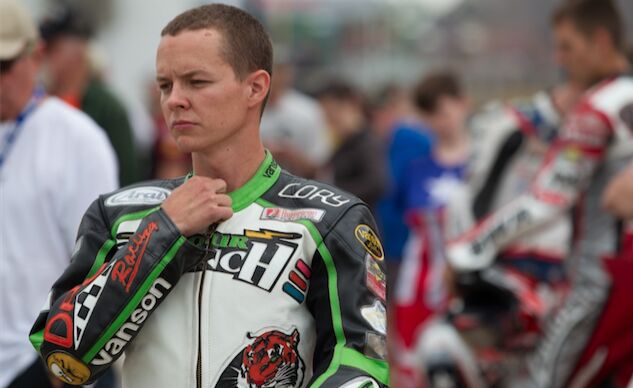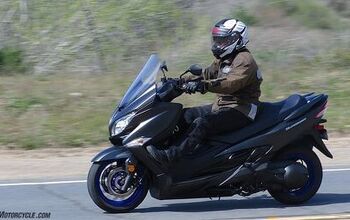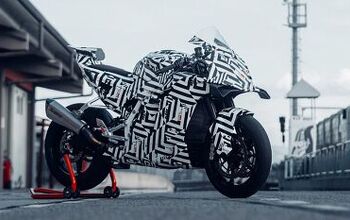A Look Into The Privateer Life of American Flat Tracker Cory Texter
An interview from AmericanFlatTrack.com
The motorcycle industry may be facing hard times right now, but there’s never been a better time to be a fan. There’s a competitive racing series for every discipline and level of riding. From on-road to off-road, motocross and supercross to MotoAmerica and MotoGP, just to name a few. We also can’t forget about all the crazy new enduro series popping up all over the world, and quite possibly thee most exciting of the bunch: American Flat Track.
American Flat Track racing has grown hand over fist in popularity over the last couple years and manufacturers have undoubtedly taken notice. Contingency incentive offerings to racers this year have almost reached $2 million – and still continue to grow. Harley-Davidson and Indian Motorcycles have contributed about half of that money, bringing $562,500 and $358,000 to the table, respectively. Many other household-name brands round out the remaining mil. If the racing weren’t exciting enough, these added take-home incentives ought to make the competition that much spicier.
This year’s 18-round series travels all over the United States, and seeing the racing live will generally cost you about 30 bucks per ticket – not much more than a trip to your local movie theater after adding popcorn and a drink. Watching from home has never been easier, either. Most rounds can be watched on NBCSN and if you don’t get that channel, every race can be streamed live on FansChoice.tv. We all have internet now, even hobos update their status from vans down by the river – so no excuses. Next time you’re flipping through Netflix deciding on which movie you’ve already seen three times to watch, consider maybe checking out a race. Just saying…
But enough with all that noise. The purpose of this article isn’t to evangelically convince you to watch motorcycles go around in circles, but rather to shine some light and take a deeper look into the life of a privateer racer. The American Flat Track interview below with seasoned-veteran Cory Texter, outlines some of the challenges and obstacles, as well as the motivation and triumphs that come with the do-it-yourself territory.
There are only a handful of racers competing in the American Flat Track series that have full factory backing, which means the vast majority are all guys (and girls) out there doing it on their own. To me, the privateer effort is much more interesting than a full-fledged corporate-backed team because it requires a whole lot more creativity and sacrifice. It also shows that average Joes with the right attitude and motivation can go out there and dice it up, too. And besides, who doesn’t like a good underdog story?
Related: Support Your Local Racetracks
Begin American Flat Track Interview:
Congratulations on being a new father. How’s that going?
Thank you! Being a dad has been such an awesome thing for me. Growing up, I always wanted to experience that, and now it’s happening. It’s also made me a better rider. Before, when I’d have a bad race, or something would go wrong, I’d be down and frustrated and stressed about it. But now I’m seeing the bigger picture, and I have more perspective about what’s important in life, and I’m not stressing nearly as much. I’m smiling more, riding more relaxed, and dealing with things in a better way. It’s funny, too, because my son Cruise was born during this year’s Springfield Mile. I missed the race, which was a bummer because I’d gotten third the year before. But being there for his birth was just awesome.
How’s the offseason been?
It’s going well, and it’s been nice having some extra time to spend with Cruise and my wife Amber. All during the season I’m always thinking that I can’t wait for some time off to do the things I don’t get to do during the season … and then the offseason comes and I can’t wait to get back on the race track! It’s funny how that works. I’ve done some indoor races and won a couple of those. Other than that, I’ve mainly been working on my program for next year, doing some promotional work for other racers and training for 2018.
After a successful 2016, you struggled to equal that success in 2017. What was the deal?
I felt like we didn’t hit our peak in 2016, but we were on the right path. Heading into 2017 I was really excited, worked extremely hard and put together what I thought was a strong package. I bought a motorhome, built a second twin for the miles, and things were looking good. The funny thing about racing is that it’s very unpredictable. It all started in Daytona, really. I felt decent, but I broke a shifter on the second lap in the main. The next weekend I lost a chain on the last lap at the Woodstock national. Two races in and I was already in a pretty big hole. At the first mile in Arizona, I had a brand-new motorcycle that I was excited to race. I was running second in my heat race and I lost the brakes and crashed. I got the brakes fixed for Springfield but had a transmission failure during the first qualifying practice. It was just one of those seasons. I bounced around on some different teams, and just never really rode to my potential.
How do you find motivation during a season when you are struggling week after week?
It was very difficult last season, honestly. There was a point during the summer where I came home from a race and pretty much just laid on the couch all week. For me that’s really saying something, because I always try to stay positive and continue grinding. I was just emotionally worn out. I pour everything I have into this sport and to struggle like we did after putting in so much work during the week was very discouraging. Racing is dog-eat-dog. In 2016 I was on the podium multiple times and came close to winning races. A few months later people were calling me washed up and telling me I sucked. [Laughs] You’re only as good as your last race and you have to keep proving yourself week after week, and I’m OK with that.
What are the pros and cons of running your own team?
I enjoy running my own team but it has many challenges. I am not a very good mechanic, so if we had mechanical issues like we did in 2017, I wouldn’t have the knowledge to fix them myself. I would usually make the three-hour round trip to Baltimore a couple times a week so my friend Justin Bender could fix the bikes. Without Justin I wouldn’t have been able to even race, so I owe a lot to him. The guy who built my engines lives in Iowa and I often got my bikes dynoed in Michigan, so for many races it was a lot of “I think it will be alright…” and we just went to the races. It was hard to be a racer and compete against guys like Jared Mees and Brad Baker who really only have to focus on racing and not all the logistics of running a race team. I do like being able to make my own decisions with running my own team. Sort of sink-or-swim type of thing. I like being able to put any blame on myself and not someone else.
So what’s the game plan for Cory Texter in 2018?
The cost of running my own Twins effort was really high the past couple of seasons, as one can imagine. All the money I put into my program came from sponsorships and race winnings. I don’t have any silent sponsors or people who put up big money to back my team. A few of my bigger sponsors – such as Sour Punch Candy – stepped away from motorcycle racing, and I was back to the drawing board on what I wanted to do next season. I spent the last couple of months trying to put some deals in place, but haven’t had much luck, so it looks like I will be contending in the AFT Singles class next season. There are a lot of good reasons to go in that direction that make sense for me right now.
Can you talk about some of them?
A primary one is financial. It’s honestly very hard for privateers to compete in the Twins class right now against some of the larger teams. I don’t want to steer riders away from racing Twins; it all depends on what opportunities you have and what your goals are. For me, I just don’t have the financial backing to make it happen on my own. I am also not going to race motorcycles to be a field filler or fight tooth and nail for 11th place every weekend. I want to win races. All the bikes in the Twins class are custom-built and money can buy performance. There are six factory riders in the Twins class and a handful more with million-dollar budgets. Singles are quite a bit less expensive to campaign. In addition, the bikes are all essentially equal, and good performances are more often than not left up to the rider. I like that; it’s intriguing to me. I know that some will have a problem with my decision, but I have to do what’s best for myself and my family. I’m a racer, and I want to keep racing motorcycles, keep growing this sport. People can’t say I couldn’t hack it in the Twins class because I have been on the podium multiple times against the million-dollar teams while pitting out of a borrowed van. It’s just about being smart and making the right decisions. I think riding a single will be a fun transition.
Care to talk a little about your program and sponsors for 2018?
I am still putting things together. I have a few wonderful supporters that have really stepped up, such as Lancaster Honda, Law Tigers, Stay The Course, Durelle Racing and others. I recently bought a leftover 450 to start training on. Much of the support I have is from companies that sell products aimed toward singles or motocross bikes, so I had a lot of them pushing for a change in class when I discussed my financial situation with them this off season. I feel like I can give back to my loyal sponsors a bit more effectively in the Singles class. I’m headed down to Florida the first of the season to start riding and training. Things are better with the economy than a decade ago, but times are still tough. I sold my motorhome and will once again be borrowing Shayna’s van and pink toolbox to go to the races. It will be a modest effort, but sometimes that is when I race my best. There is a lot of potential for exposure right now with the TV schedule on NBC Sports Network and I really push my sponsors hard on and off the track, so if anyone is interested in teaming up, I would love to work out a deal. There is no lack of hard work on my part, that’s for sure. I’m still finalizing some deals for 2018, and am hopeful I can announce more concrete plans in the near future.
You’ve had success on a Twin. Would you consider racing one if a good opportunity came along?
Absolutely. The goal, obviously, is to race in the premier class against the top riders, but there just aren’t a lot of opportunities available right now to compete there. If a good opportunity came together to ride a twin, I would certainly consider it. I’m definitely not ‘cherry picking’ here by moving to Singles; anyone who knows me will vouch that I’ve never taken the easy road in my entire career. In fact, I don’t think racing Singles will be easier by any means; each class has its challenges.
Have you been more successful riding a Twin or a Single in your career?
I’ve had good and bad races on both. I think I’m a more consistent rider on a single, but I haven’t really been focusing on Singles the past few years. The only 450 I’ve raced in the past four years is a 2010 Honda that sits in my garage until it’s time to race it. Afterwards I wash it and it goes back into garage. I bought the bike as it sits from a local amateur rider before Daytona in 2014 and have been racing it everywhere from concrete indoors to big, fast clay Half Miles. I’ve never even dynoed it. True story. Twin or single, it doesn’t matter; I’m a racer and I just want to race motorcycles.
The Singles class is looking pretty serious for 2018, with some fast, young rookies and some seasoned veterans competing. Why do you think the class is such a draw now?
With the new rules, and the amount of really quality TV coverage, the Singles class is a serious deal, and not just a feeder class anymore. When I turned professional this class didn’t exist. I got my pro license and my first race was in the ‘big boy’ class against guys like Chris Carr. The Singles class is a great entry-way, and it’s significantly cheaper to compete in, so that draws a lot of riders. Also, the most appealing thing to me is that the bikes are essentially equal. I won’t go into races feeling like I’m already in a hole, racing on subpar equipment.
Who do you think the front runners in Singles will be?
I am not sure, but I have a lot of respect for the Singles riders. Some of these kids would give the top guys a run for their money if everyone was riding a Single. The field is deeper in the Twins class, but talent level is still no joke in Singles. What most of these riders lack in experience they make up for in aggressiveness and determination. I’m not really focusing on one specific rider. I’ve been watching videos from 2017 and I know it’s gonna be a lot of work. It’s a long season, so I am just going to focus on myself and take it one race at a time.
You will be racing your younger sister Shayna on a consistent basis in 2018, and she won five races in 2017. Let’s talk about that.
Yeah, I am actually looking forward to it. Aside from the TTs, she was the rider to beat last season. She didn’t make any of the TT main events and was still in the title hunt at the last race of the year. That’s crazy, and it says a lot more good about her than bad in my opinion. I am her biggest fan and I will be the first one to congratulate her whether I am racing against her or not. She actually just bought her first house, so if things get rowdy on the track between us, we don’t have to glare at each other at the dinner table anymore!
More by Brent Jaswinski



































Comments
Join the conversation
The news is of the riders going down to singles, to include the twins Rookie of the Year and former singles champion Ryan Wells.
Today Springfield tickets are on sale! https://www.springfieldmile...